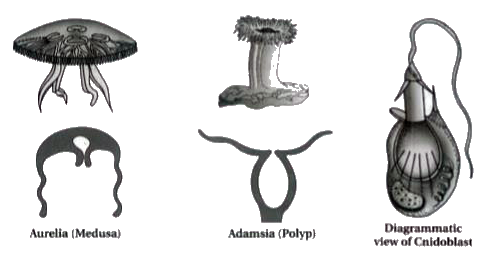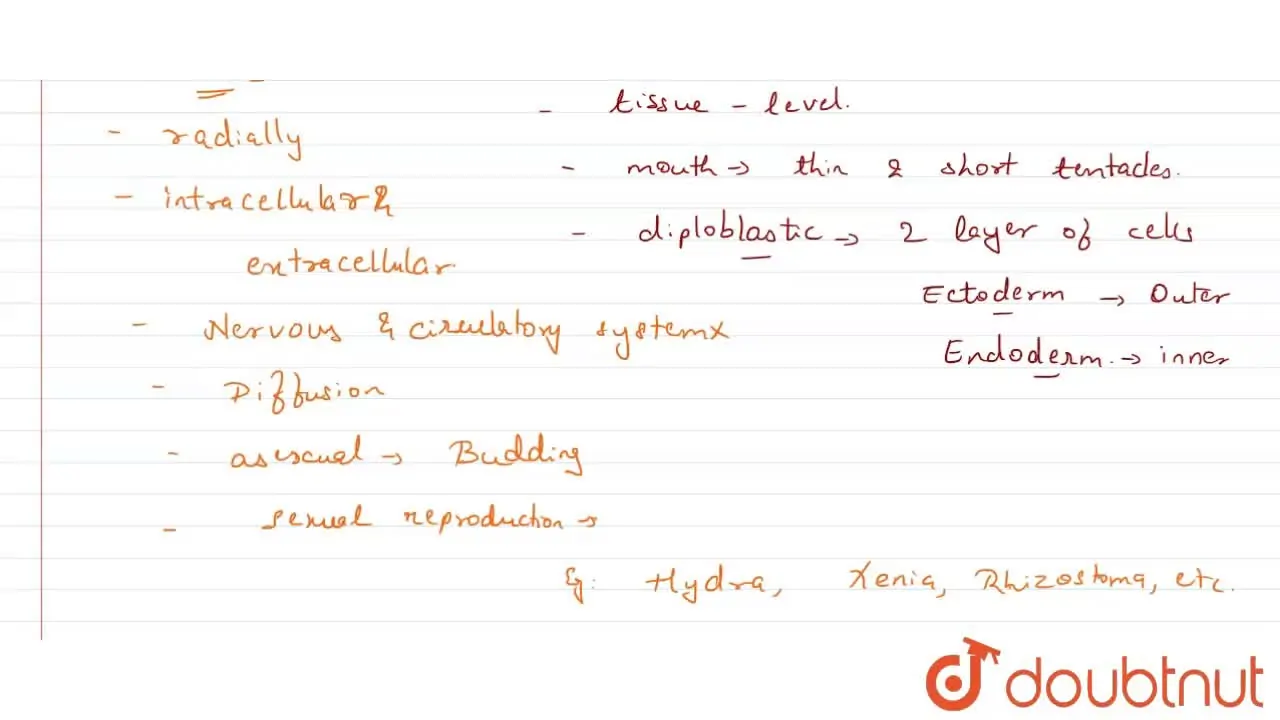Give general characteristics of phylum coelenterata/cnidaria. Solution in Gujrati
There are about 9000 species of Cnidarians.
The name cnidaria (Knide-nettle or sting cells) is derived from the stinging cell or Cnidoblasts present on the ectoderm of tentacles and body of these animals.
Cnidoblasts are used for anchorage, defense and for the capture of prey.
Cnidarians exhibit tissue level of organisation and are diploblastic
They have a central gastro-vascular cavity with a single opening, hypostome.
Digestion is extracellular and intracellular. Some of the cnidarians, e.g., corals have skeleton composed of calcium carbonate (CaCO3).
Cnidarians exhibit two basic body forms called polyp and medusa.
Polyp is a sessile and cylindrical form like Hydra, Adamsia, etc. whereas, the medusae is umbrella shaped and free-swimming like Aurelia or jelly fish.
Those cnidarians which exist in both forms exhibit alternation of generation (Metagenesis) i.e., polyps produce medusae asexually and medusae form the polyps sexually (e.g., Obelia).
Examples : Physalia (Portuguese man-of-war).
Adamsia (Sea anemone).
Pennatula (Sea-pen).
Gorgonia (Sea-fan)
Meandrina (Brain coral)
Aurelia (Jelly fish)
Obelia (sea fur)

Examples of Coelenterata indicating outline of their body
Related Playlists
- BOOK - KUMAR PRAKASHANCHAPTER - ANIMAL KINGDOMEXERCISE - SECTION - B (DIFFERENCE/SCIENTIFIC REASONS)16videos
ANIMAL KINGDOM
- BOOK - KUMAR PRAKASHANCHAPTER - ANIMAL KINGDOMEXERCISE - SECTION - C (DEFINITION/EXPLANATION - TERMS/LOCATION - FUNCTION)32videos
ANIMAL KINGDOM
- BOOK - KUMAR PRAKASHANCHAPTER - ANATOMY OF FLOWERING PLANTSEXERCISE - QUESTIONS FROM MODULE (QUESTION PAPER)10videos
ANATOMY OF FLOWERING PLANTS
- BOOK - KUMAR PRAKASHANCHAPTER - BIOLOGICAL CLASSIFICATIONEXERCISE - OBJECTIVE SECTION (FILL IN THE BLANKS)10videos
BIOLOGICAL CLASSIFICATION
Similar Questions
Give difference :
Diploblastic and Triploblastic07:24View SolutionDefinitions/Explanation:
Poikilotherms:01:44View SolutionWhich tissue is responsible for primary growth ?
02:26View SolutionFill in the blanks
In diatoms the cell walls form two thin overlapping shell which fit together as in .......03:18View SolutionPHYLUM – COELENTERATA (CNIDARIA)
05:01View SolutionThe most important characteristic of phylum Cnidaria is
05:11View SolutionThe characteristic larva of phylum coelenterata is
01:47View SolutionPhylum Coelenterata (Cnidaria)
06:01View SolutionWrite five characteristic features of Phylum Cnidaria?
04:04View SolutionList the general characters of Phylum Coelenterata.
View SolutionThe characteristic larva of phylum Coelenterata is
01:06View SolutionGive general characters of phylum Porifera or Coelenterata. Give a few examples also.
07:39View SolutionWrite the general characters of the phylum cnidaria.
03:18View SolutionThe main characteristic of the phylum Cnidaria is the presence of
01:08:00View SolutionThe characteristic larva of phylum coelenterata is
02:48View Solution


